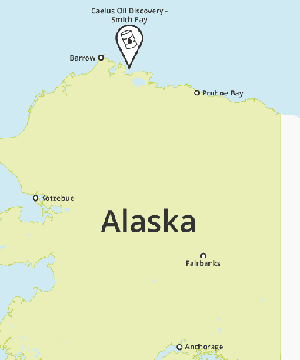
A small U.S. oil and gas company called Caelus Energy LLC just struck black gold in Alaska...
That's why for oil, Alaska just became the next North Dakota.
According to an Oct. 5 press release, the private company's new oil discovery could yield up to 10 billion barrels of light oil, which is more easily recoverable from the ground than other types of oil. To put that amount into perspective:
- Based on the current WTI oil price of nearly $50 per barrel, Caelus' production efforts could produce upwards of $10 million worth of oil per day.
- The highly touted West Texas oil discovery on Sept. 8 is thought to contain three billion barrels of oil - 7 billion less than the Alaskan discovery.
- The North Dakota Bakken Region and East Texas Oil Field (the largest in the United States) contain a combined4 billion barrels of oil. That's nearly worth the size of Zimbabwe's annual GDP.
The newly discovered 126-square-mile field is located in Smith Bay, an area just 30 miles north of the Arctic Circle.
In a public statement, Caelus CEO Jim Musselman said the discovery was so significant, that it could "play a meaningful role" in sustaining the Alaskan oil business over the next three or four decades. Although Caelus has only done preliminary testing, the discovery could increase Alaska's oil reserves by a staggering 80%, according to Forbes.
Don't Miss: Are you doing everything you can to grow your retirement "nest egg"? You can start today with our top 5 money-making investment reports - they're absolutely free...
What's truly remarkable, however, is how Caelus' discovery looks compared to the massive North Dakota oil discovery between 2006 and 2012.
The comparison makes Alaska the new oil capital of the United States...
Here's Why for Oil, Alaska Just Replaced North Dakota as the Hot Spot
[mmpazkzone name="in-story" network="9794" site="307044" id="137008" type="4"]
According to early estimates, Caelus could be churning out 200,000 barrels of oil per day from its new discovery.
Now compare that to North Dakota's big oil boom...
At their peak, oil companies in the Bakken Region in North Dakota and Montana were producing about 1 million barrels per day. As of April 2013, the latest estimate for the region suggests a final recovery of 7.4 billion barrels of oil, according to the U.S. Department of the Interior.
But Caelus is just one tiny company. The average rig count in North Dakota was between 180 and 190 throughout 2013, according to state estimates. If Caelus decides to sell the rights to work the field to other oil companies...
...that means more rigs - and more oil. Possibly far more than North Dakota could ever produce.
What's more, the oil field is located in shallow waters near land, which will make it easier to reach than past oil discoveries in Alaska. For instance, Shell's $7 billion Arctic drilling campaign was in the deep waters of the Chukchi Sea. Because the oil was so deep, it was harder to recover, and ultimately led to Shell canceling the project on Sept. 28.
The Caelus discovery could give Alaska a much-needed boost to its economy and oil production levels.
At its height in 1988, Alaska was producing 2 million barrels of oil per day, according to Forbes. Today, that number has decreased to 483,000 barrels of oil per day, according to the U.S. Energy Information Administration. Caelus could help boost that number to 683,000 or more. And that number could be even higher if other oil companies are allowed to drill on the site.
We'll really know the extent of Smith Bay's potential after the next appraisal well. An appraisal well is used to assess characteristics of an oil field, such as flow rate and reserve quantity. That's planned for 2018, according to CNBC. Next, after three to five years of going through the regulatory process, oil could flow through the trans-Alaska pipeline system (TAPS) in 2020. TAPS is one of the world's largest pipeline systems and runs nearly 800 miles from Prudhoe Bay to Valdez, Alaska.
Up Next: The Secret Way Our Enemies Use Our Energy Infrastructure
Follow us on Twitter @moneymorning and like us on Facebook.


